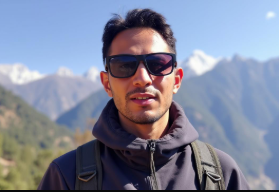Annapurna Base Camp Trek-7 Days
Trip Type
Trekking In Nepal
Accomodation
Tea House
Destination
Nepal
Start Point
Kathmandu
Region
Annapurna Region
Duration
7 Days
Annapurna Base Camp Trek is a short and famous trek in the north-central region of Annapurna. It offers you panoramic views of mountains like Annapurna I, Machapuchhre(Fish Tail), Hiunchuli, and Annapurna South. During the journey you can experience the diverse landscapes, and diverse ethnic villages of Magar, Gurung, Thakalis and Lobas. Also you can experience the rich cultures, traditions, Buddhist shrines. The time duration is short, offering the authentic experience of typical alternative Annapurna Base Camp.
Seasonal Information
The weather varies according to the season in the Annapurna region that influence the experience of trekkers. During spring season (March-May), the temperature is moderate, you get to see clear skies, with vibrant rhododendron blooms. Likewise in Autumn season (September-November), which is the most popular for trekking that offers stable weather and excellent visibility. Also the temperatures at day time are comfortable compared to night one. For Winter Season (December-February), the region suffers cold temperature, primarily at higher altitudes and snow may cover some of the trails which makes it more challenging for trekkers. Lastly for Monsoon (June-August), rainfall can make trails slippery and risky. Despite that the rich greenery gives the unique perspective to the region.
Cultural and Natural Insights:
You can explore and connect to the diverse ethnic community of Annapurna region. The culture and tradition gives you the spiritual connection, peace of the trek. There are mostly Gurung, Magar, Thakalis, Lobas and Mananges communities. Gurung and Magar are located in the southern part of the region and known for their lively tradition, folk dances, and warm hospitality. Likewise Thakalis, Lobas and Mananges are located in the northern part of the region. They are very much influenced by Tibetan culture and they present unique architecture, monasteries and language. From a natural perspective, this trek offers you diverse flora and fauna. You can encounter wildlife like Himalayan Monal, Langurs, Himalayan goats. Similarly, the Machhapuchhre Base Camp (MBC) and Annapurna Base Camp (ABC) offer you the stunning views of the Himalayas.
Preparation Guide:
A travel essential list ensures safety and comfort throughout the trek. For clothing you need moisture wicking base layers, insulated jackets, waterproof jackets and pants, trekking pants and shirts, thermal innerwear, warm hat, gloves, and scarves, sturdy waterproof trekking boots. For Gear you need trekking poles, sleeping bag, backpack, headlamp with extra batteries, sunglasses with UV protection, water bottles or hydration bladder, water purification tablets. Also you need essentials like sunscreen and lip balm, snacks and energy bar, map and a guide book, lightweight towel, cash for teahouses and local expenses and personal first aid kits. You can learn more in our detailed guide on difficulty level of Annapurna Base Camp trek.
Sustainability and Responsibility:
The ecosystem of Annapurna region has been significantly impacted by increasing tourism. Trekkers have some responsibilities towards the environment to preserve the beauty of the Himalayas for our own good and for the future generation. Here are some ways to practice environmental responsibility:
- You can carry garbage bags with you or dispose of trash in designated areas.
- Avoid using single use plastic water bottles.
- Choose accommodation that follows sustainable practice.
- You can purchase local goods to uplift/support the local economy.
- Avoid picking rare plants that take long to grow and respect wildlife and their habitat.
- Travel in groups to reduce ecological strain.
Modern Trekkers Expectations:
Now trekkers seek balance between adventure and the outside world while in trek to be connected. Here are some expectation of modern traveller that we try to meet:
- Internet access as wifi is available at Kagbeni, Jomson, and Muktinath.
- Comfortable accommodation due to upgraded hygiene facilities.
- Available expanded menu of options including pizza, pancakes, and vegetarian dishes.
- You can enjoy thakali sets, momos, and apple pies for food.
- Sustainable and ethical practices as sustainable practice of waste management and using renewable energy.
- The trek is through remote valleys and high altitude passes.
- You can combine the trek with the highest lake in Nepal that is Tilicho.
Why Trek to Annapurna Base Camp with Nepal Outdoor Expeditions?
At Nepal Outdoor Expeditions, we’re more than just a trekking company, we’re your trusted partner in creating an unforgettable Himalayan journey. Our expert local guides not only prioritize your safety but also offer deep cultural insights that enrich your experience.
With carefully crafted itineraries that strike the perfect balance between adventure and comfort, we’re committed to responsible trekking and personalized service. Whether you're setting out on your first trek or you're a seasoned hiker, our dedicated team ensures your Annapurna Base Camp adventure is smooth, meaningful, and truly memorable.
Learn More About Annapurna Base Camp
Highlights of the Annapurna Base Camp Trek-7 Days
-
Offers Stunning views of Annapurna and Dhaulagiri mountain ranges.
-
A popular viewpoint for sunrise from Pooh hill.
-
Starting point from Pokhara, the city of lakes.
-
Manage the rural village at 3,519 meters offers the sight of Gangapurna Glacier at 3,540 meters
-
Experience of hot springs which provide a relaxing end of trek.
-
Bonus stop at Machhapuchhre Base Camp for the stunning view of Machhapuchhre Himal.
-
You can experience the diverse Landscapes like lush forest, rhododendron forest, glacier moraines, terraced fields.
Short Itinerary ( 7 days )
After you reach Nayapul, your trek commences. The route begins with ascending through villages, farmed land, and lush forests. You’ll pass Birethanti and climb towards Ghandruk which is a small village that offers the stunning views of mountains. Distance: 10 km, walking hours: 5-6 hrs, altitude gain: 870 m.
You’ll pass through rhododendron forest descending to Kimrong Khola. The route steeply goes towards Chomrong before hitting the Annapurna Sanctuary. The village offers stunning views of mountains. Distance: 9 km, walking hours: 5-6 hrs, altitude gain: 230m and altitude loss: 300 m.
You’ll ascend to Sinuwa(2340 m) crossing Chomrong Khola. The trail passes through dense bamboo forest following Dovan. Then a final climb to Himalayan and stay overnight at a teahouse. Distance: 10 km, walking hours: 6-7 hrs, altitude gain: 750 m and altitude loss: 200 m.
You’ll climb past Hinku Cave and witness the vegetation start to thin as you reach Deurali. You’ll reach MBC that offers stunning views of Himalayas and Following the route later you’ll reach ABC where you’re surrounded by snow capped mountains. Distance: 12 km, walking hours: 6-7hrs, altitude gain: 1210 m.
After watching the early sunrise from ABC, you’ll trek back to Bamboo passing MBC, Deurali, Dovan. After somewhile you’ll reach Bamboo, a dense forest for settlement. Stay overnight at a tea house. Distance: 15km, walking hours: 6-7, altitude loss: 1820m.
After some ascend and descend and final climb to Chomrong village, you’ll reach Jhinu Danda. It is a village famous for natural hot springs. You can enjoy the hot springs and relax in Jhinu Danda. Distance: 9km, walking hours: 5-6, altitude gain: 150m, altitude loss: 680m.
A final trek day which is to Siwai. You’ll descend following the Modi Khola. After reaching Siwai, you’ll drive to Pokhara concluding the journey. Distance: 6 km trek +2 km drive, walking hours:3-4, altitude loss: 958m.
Cost Includes
-
Cost of permits and paperwork
-
Transportation cost
-
Accommodation
-
Meals and Drinks
-
Cost of trekking staff
-
Miscellaneous cost like government tax and service
Cost Excludes
-
Personal expenses
-
Trekking gear and equipment
-
Insurance and emergency cost
-
Tips for guide or porter


.png)

